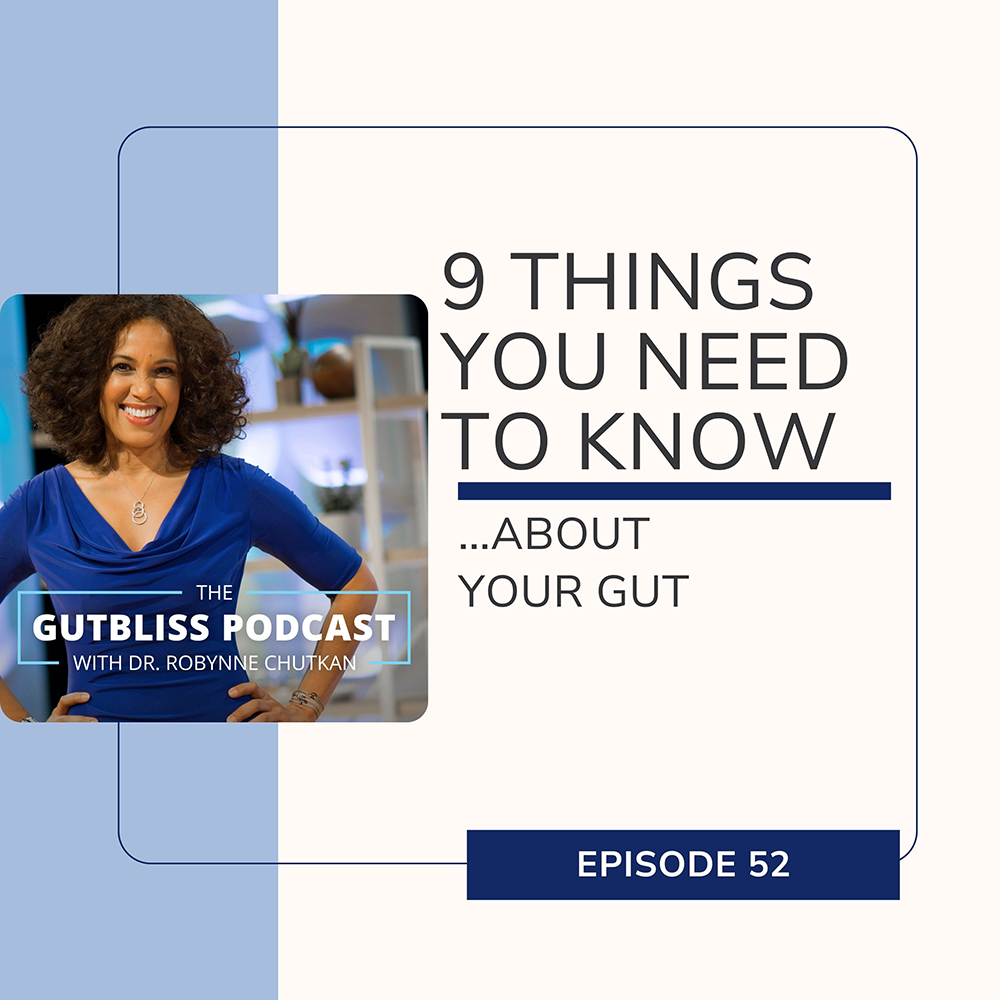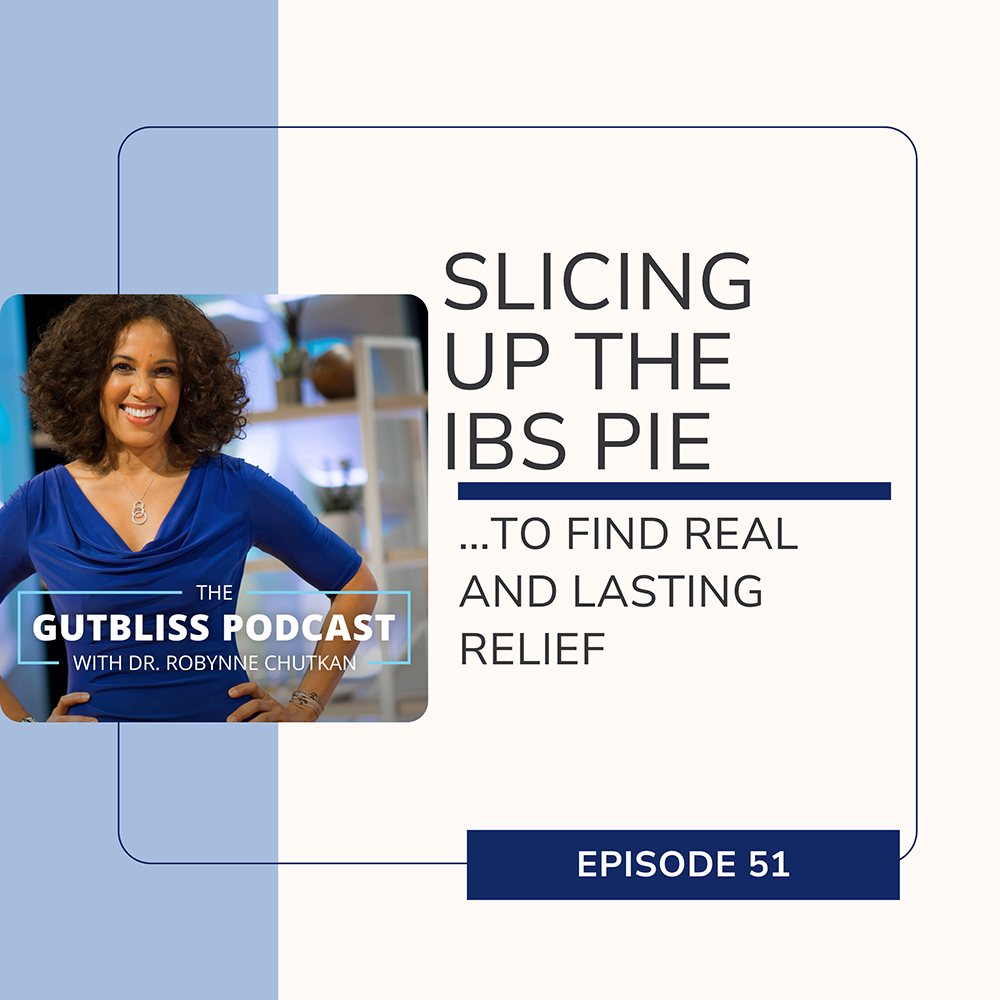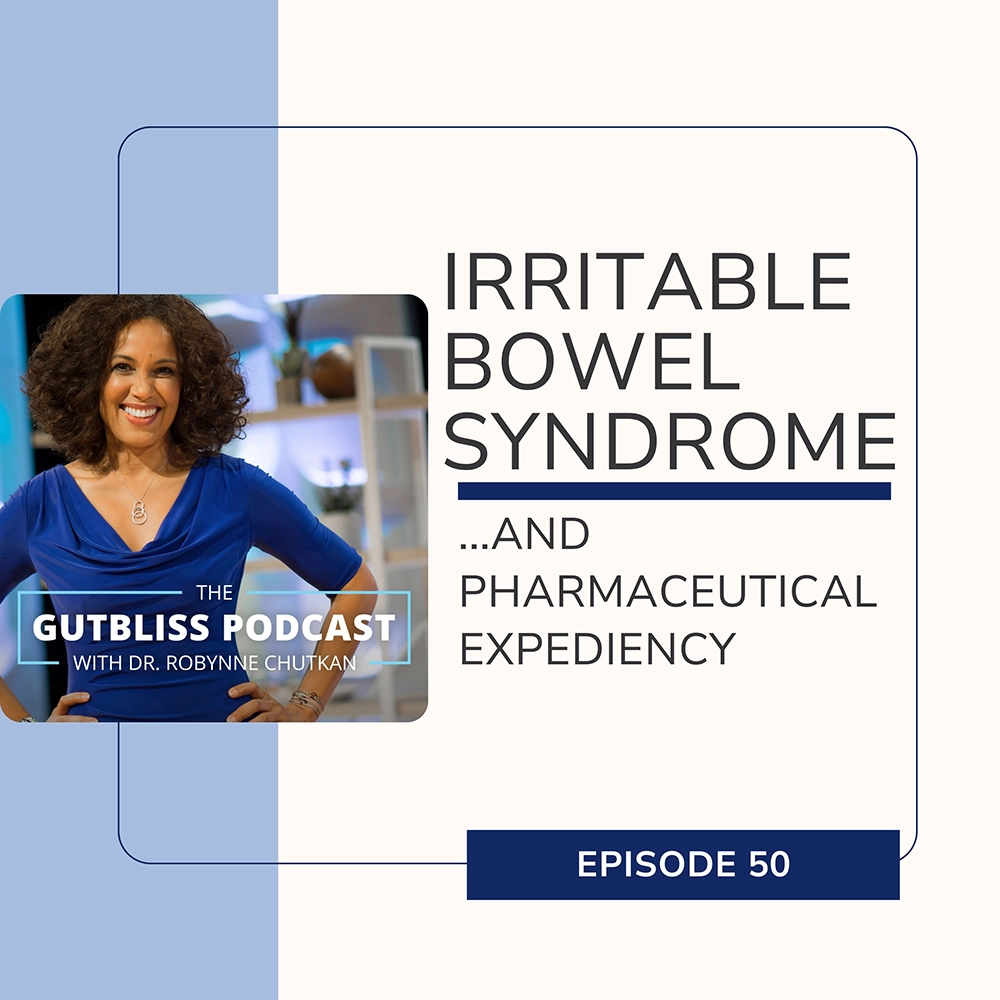Diverticulosis is the direct result of a diet that’s too low in fiber. When your colon has to contract more vigorously to expel small, hard stool that’s characteristic of a low-fiber diet, it causes a lot of pressure in the wall of your colon. This leads to small bulges, which eventually become diverticulosis. I’m seeing more and more patients in their twenties and thirties with diverticulosis, a disease that’s supposed to strike in your 60s and 70s, and the explanation is on our plate. In this episode: how to reverse symptoms and halt progression of diverticulosis.
Thank you for being a part of our community! For the latest in digestive wellness go to https://gutbliss.com/ and follow us on Instagram for more gut health info.
On today’s episode of the Gutbliss podcast, Barbara is a fifty-seven-year-old judge who came to see me about her bowel habits. Having a bowel movement had become a full-time job. She would have a smallish log after her morning coffee, but things would deteriorate after that with multiple, pellet-sized bowel movements. Every time she moved her bowels, she could feel that she still had more stool inside, but she just couldn’t get it to come out. And after each BM, within an hour she was back in the bathroom for another try.
Barbara was experiencing something called tenesmus, the medical term for a feeling of incomplete evacuation that can occur when your colon isn’t emptying completely. As a result, she was feeling full and sluggish. She didn’t want to go out to dinner, she didn’t want to go to the gym, she didn’t want to be intimate with her husband. What she wanted was to get the stool out of her colon and into the toilet.
Barbara told me one of the things she was really embarrassed about and struggling with was keeping her underwear clean. She was having problems with leakage, as well as “wet gas.” She had to wear a panty liner to absorb the leakage and occasional stray pellets. She was also going through mounds of toilet paper from endless wiping.
Things had been fine in the bathroom for Barbara until about three years ago. She’d had her first screening colonoscopy seven years ago when she turned 50 (although we recommend it at age 45) and had been told by the gastroenterologist who did the exam that everything was normal, although she wasn’t having any symptoms at the time 7 years ago. Her primary care doctor was not telling her that she likely had IBS and recommended that she consider stepping down from her position as a federally appointed judge to do something less stressful. But Barbara wasn’t stressed out by work; she was stressed out by her bowel movements.
I asked Barbara to bring in all her old records for me to review, including the colonoscopy report from 7 years ago. And I want to stress how important this is, to review the records yourself. I do a lot of second opinion consultations, and I can’t tell you how often somebody will say, yes, I had that test, and the doctor told me it was normal. And then when I actually get the result of the CAT scan or the ultrasound or the colonoscopy, I see that it was not normal at all. Get a copy of the report and read it. It may have a lot of medical-speak but what you want to pay attention to is the impression at the bottom of the report where the person who’s doing the test gives their interpretation of what’s going on.
Barbara’s colonoscopy report described a narrowed sigmoid colon due to bowel wall thickening and a few scattered, shallow orifices in the lower part of her colon: classic early diverticulosis, otherwise known as potholes in the colon.
Almost half the population over age fifty in the US has diverticulosis. Since that’s close to the age when we recommend a colonoscopy to screen for colon cancer, it’s not surprising that it’s one of the commonest things we see on colonoscopy—often as an incidental finding in someone who’s asymptomatic.
The good news is that diverticulosis isn’t a risk factor for colon cancer, and it usually doesn’t require medical intervention the way other conditions like polyps, ulcerative colitis, or Crohn’s do. The not-so-good news is that for this same reason it tends to get overlooked as an inconsequential finding, and it may even not get mentioned to someone who’s asymptomatic, as was the case with Barbara when she had her first colonoscopy.
I decided to repeat Barbara’s colonoscopy because it had been 7 years since her last one and her symptoms were quite severe. When I took a look at her colon, the diverticulosis was much more extensive than on her previous exam. Instead of the little dimples of 7 years ago, she now had large craterlike potholes, making the lower half of her colon look like Swiss cheese.
Barbara’s mother, aunt, and paternal grandfather all had diverticulosis. But diverticulosis isn’t genetic, it’s just extremely common in more developed countries because of our diet, and people from the same family tend to eat the same way, so they have the same risk factors for developing it. Barbara grew up in the Midwest eating the same meat-and-potatoes diet that the rest of her family ate—greens were garnish to put around the roast beef, and a salad usually involved Jello.
Diverticulosis is the direct result of a diet that’s too low in fiber and too high in animal products and ultra-processed foods. When your colon has to contract more vigorously to expel small, hard stool that’s characteristic of a low-fiber diet, it causes a lot of pressure in the wall of your colon. This leads to small bulges, which eventually become diverticulosis, frequently referred to as pouches, pockets, or potholes. I’m seeing more and more patients in their twenties and thirties with diverticulosis, a disease that’s supposed to strike in your 60s and 70s, and the explanation is on our plate.
In sub-Saharan Africa and other parts of the world where people eat lots of high fiber root vegetables and legumes and whole grains, and not a lot of animal products or ultra processed foods, they have big bulky stools that drop effortlessly from their rectum, and they also have something else: very low rates of diverticulosis. Those high-fiber bowel movements don’t require vigorous contractions of your colon, they don’t leave any messy residue requiring reams of toilet paper or cause leakage because your colon is emptying completely. They create what I call the clean wipe. One or two swipes, and you’re done. In the United States the recommendation is 25 to 35 grams of fiber a day, but if you’re eating anything resembling the Standard American Diet (SAD), you’re only getting about 10 grams and you’re probably having schmeary stools and a very messy cleanup, not a clean wipe. You are also at risk for problems like diverticulosis and colon cancer.
Diverticulosis can occur anywhere along the length of your colon, but it’s most common in the sigmoid, the lower part of your colon that works the hardest to push stool into your rectum. That pushing when the stool is particularly hard and small, like we see when you’re not eating enough fiber, causes the sigmoid to become thickened, and develop potholes – otherwise known as a diverticular orifice. Stool can get stuck in those potholes, sometimes for days or even weeks at a time. The combination of potholes filled with stool and a narrow, thickened colon makes you feel really full, bloated, and uncomfortable. Your sigmoid colon is located in the lower left part of your abdomen and sometimes extends across the midline to just above the pelvic bone. That’s where most people have discomfort and sometimes people mistakenly think it’s a problem with their bladder.
So now your thick sigmoid colon full of stool is pressing down on your rectum and creating a strong sensation that you have to have a bowel movement. But here’s the problem: there isn’t actually enough stool in your rectum to trigger contraction of the muscles necessary for a bowel movement to happen (check out episode 2 of the Gutbliss Podcast “Shy Bowel” for more on how this works). So you’re in and out of the bathroom because you have all this pressure from your sigmoid colon. It feels like you have to go, but the stool is stuck in your sigmoid instead of being down in your rectum. Finally the potholes begin to empty, and you start to have a little action, but it takes multiple trips because the potholes don’t all empty at once. You end up squeezing out a couple pellets, or toothpaste-like ribbons of stool that are pretty unsatisfactory. Having multiple small bowel movements but still feeling constipated is the most annoying symptom of diverticulosis and also the most characteristic.
Can diverticulosis turn into a more serious problem? Yes, two possible complications include diverticulitis where the potholes become inflamed or infected, and bleeding. Nonsteroidal anti-inflammatory drugs (NSAIDs), increase the risk of both bleeding and diverticulitis. When we come back, how do we treat diverticulosis and get rid of those incredibly frustrating symptoms?
If you have complications of diverticulosis, like an acute attack of diverticulitis, then bowel rest with a liquid diet and no fiber for a few days is often the best course of action. You may need antibiotics if you have a fever or a lot of tenderness, and on rare occasions, you may even need surgery to remove part of your colon if you develop a serious complication like an abscess. But remember, complications like diverticulitis and bleeding are the exception not the norm. Most people with diverticulosis will never experience them. For more information on how to manage diverticular disease, including acute attacks, check out the Gutbliss Guide to Diverticulosis, which you can find at Gutbliss.com under Gut Guides.
If you are like most people with diverticulosis and you have symptoms but no complications, dietary change can make a big difference. When Barbara and I sat down to formulate a plan, one of the things I asked her to do was aim for more than 30 grams of fiber. But with one caveat: I asked her not to count any of the grams of fiber from cereal, pasta, baked goods, or bread.
Not all fiber is created equal when it comes to bowel movements. Unprocessed, naturally occurring foods like fruits, vegetables, squash, yams, nuts, seeds, and beans provide the type of fiber that has way more bang for the buck than what we get from processed sources like breakfast cereals, whole wheat bread, fiber bars, chips, and baked goods, no matter what the nutritional label on the package says.
Even though Barbara was eating a fair amount of fruits and vegetables, a lot of it was tropical fruits, like pineapple and bananas, and salad with iceberg lettuce. These foods have valuable nutrients but not that much fiber. I recommended eating more apples, pears, and berries and tossing chickpeas, and broccoli into her salads and using romaine lettuce or kale instead of iceberg. But she still needed some help getting to 30 grams. I started Barbara on a tablespoon of ground psyllium husk fiber in the morning. I warned her that things might get worse before they got better, which they did. The first two weeks, as her body adjusted to the additional fiber, she was more bloated and constipated than she’d ever been and on the verge of firing me as her gastroenterologist. But then something happened.
Her bowel movements started to get bigger. Much bigger. Fill-the-toilet-bowl bigger. Clog-the-toilet-bowl bigger on one occasion. And they also started to get less frequent. Ten trips to the bathroom became 5. And then five settled into three.
Even though Barbara still had a feeling of fullness from her thickened sigmoid colon, she was much less bloated, she wasn’t spending all day in the bathroom, and she was having three stools instead of ten, so she was pretty happy with that.
I want to leave you with three takeaways about diverticulosis.
1. If your symptoms sound like diverticulosis, find out if you really have it. You can diagnose it with a colonoscopy or a CAT scan and be sure to ask if it showed any signs of diverticulosis, including thickening in the sigmoid colon or dimpling, which can be early signs.
2. If you have symptoms from diverticulosis like a feeling of incomplete emptying or multiple bowel movements, try eating a high-fiber diet aiming for 30 grams of fiber from sources like fruits, vegetables, beans, nuts, seeds, and unprocessed whole grains. And remember to get all that fiber down to your colon to unclog your digestive pipes you need to drink a lot of water, at least half your body weight in ounces of water. If you weigh 200 pounds, that’s 100 ounces – minimum!
3. If that’s still not working, consider adding a tablespoon of psyllium husk in the morning, mixed with at least 8 ounces of liquid and followed by an additional 8-ounce glass of water. You may feel full and even more bloated the first few days, but after a couple weeks your body should be used to the increased fiber, and you should start seeing improvements in your bowel habits.
So that’s it for this week’s edition of the Gutbliss Podcast on potholes in your colon. For more information on how to manage diverticulosis, including acute attacks, check out the Gutbliss Guide to Diverticulosis. You can find it at Gutbliss.com under Gut Guides.









